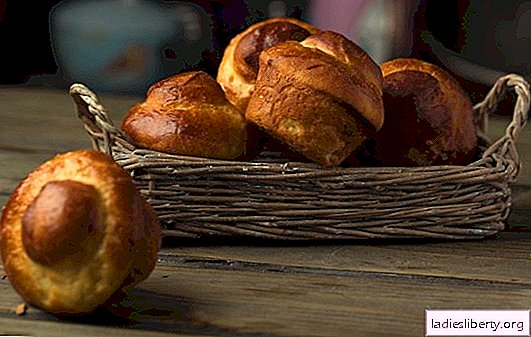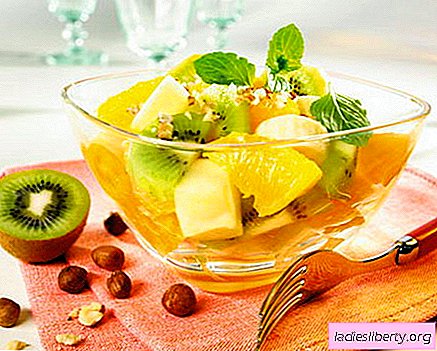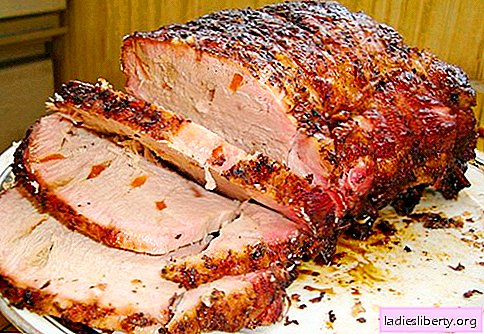
Yucca, thanks to her exotic appearance, firmly took her "place in the sun" not only in the gardens, but also in indoor floriculture.
For its long spear-shaped leaves, it is called the “Spanish dagger,” “the needle of Adam.”
About 40 species of yucca are known.
Indoor most popular for growing:
• yucca aloe - a tree-like plant, in natural conditions reaching 4-6 m in height. Leaves are hard, sharp-edged at the edges, up to 45 cm long, have a dark green color with a bluish bloom;
• yucca elephant - in nature, this is a branching tree up to 8-10 m high. It got its name for a thick trunk resembling an elephant’s foot. The leaves have a light green color and spikes at the ends, leathery to the touch. A feature of this species is the direction of the leaves in the outlet: the lower ones are drooping, and the upper ones are directed upwards.
These species have a pronounced trunk, crowned with a "cap" of long leaves. For such an appearance, they are often called a false palm. Despite the subtropical origin, yuccas are unpretentious, it is quite simple to grow them at home, subject to simple rules of detention.
Yucca: home care - soil, lighting, temperature and humidity
The soil
The soil for growing yucca must be loose and permeable, because this plant does not tolerate moisture stagnation. It can be prepared from equal volumes of turf land, humus, coarse sand (fraction more than 3 mm) or perlite. It is not superfluous to add pumice (slag), pebbles or crushed stone, charcoal (1: 1: 1) to it. There are no strict requirements for soil acidity: yuccas grow well in the pH range of 5.6-7.5. If it is not possible to select components for the soil mixture, then you can buy ready-made soil for growing yucca, for example, from the Seliger-Agro series, Gardens of Babylon, Biud, Flower Paradise, Dream of a Botanist, etc.
Lighting
For good development, yucca needs bright lighting, especially for young plants. However, to avoid leaf burns, it must be shaded at noon from direct sunlight. Optimal would be placement on the windows of the western or eastern direction. In winter, to achieve the required 16-hour daylight, you can use additional illumination with daylight lamps. In summer, the yucca can be taken out into the open air, providing it with diffused light and protecting it from precipitation.
Temperature and humidity
In the warm season, the optimal air temperature for keeping yucca is + 20-25 ° C. If the plant is on the south side, then it can overheat. In this case, it must be moved to the shade so that it cools down and then sprayed with water. Autumn-winter yucca must provide + 8-12oS. At a higher temperature and lack of lighting, the shoots of her are very elongated, the leaves become smaller, brighten and sag.
Some types of yucca need to be sprayed with warm water, which is carried out before sunrise or after sunset. Otherwise, sunburn may occur on the leaves. To increase air humidity, the pot can be placed in a container with wet expanded clay, gravel, moss.
Yucca: home care - breeding, transplanting
Breeding
At home, yucca is propagated by seeds and vegetatively.
From seed it is much easier to grow a “Spanish dagger” than to get these seeds: firstly, when kept indoors, a false palm tree blooms very rarely, and secondly, it does not set fruit (except for yucca aloelista) in the absence of its pollinator-symbiont - yucca moth. Yucca seeds have a fairly long germination (from a month to a year), therefore, to accelerate this process, they must be scarified - rub each seed with an emery cloth. Sow the seeds in a bowl with a mixture of turf land and sand and place in a greenhouse. You can keep the seeds in a moistened material (sponge, cotton pad, gauze, etc.) until hatching. For seed germination, it is necessary to maintain an air temperature of + 18-24 ° C and periodically ventilate. The emergence of seedlings from seeds sown immediately in the ground can stretch from a month to a year. After growing a couple of real leaves, seedlings are dived into separate cups. Young plants need to be replanted annually.
A simpler and faster way to breed yucca is rooting of cuttings. It is good to combine this with the planned pruning of an overgrown plant, which is done before the start of an active vegetation. The top of the yucca is cut with a sharp disinfected knife, leaving several lower leaves on the trunk (new shoots will later grow from their sinuses). Slices are dried and treated with charcoal powder. The cut off "apical" cuttings are rooted in water by adding activated carbon to prevent the development of putrefactive processes, or in a soil mixture. On the remaining trunk - the “hemp” of the sleeping buds, side shoots will begin to grow. They can be thinned out or left everything for the formation of a lush "cap" of leaves.

The rooting of the apical stem of a yucca in the ground
You can grow yucca from pieces of the trunk. They can be bought at flower shops, cut independently from an existing plant. The sale of such yucca cuttings as gift products in the southern resorts is also common - a lively "magnet" in memory of the rest. When buying such planting material, you need to pay attention to its appearance: it must be resilient and juicy, without signs of drying out or wet rot, the upper and lower ends should be marked (the upper end is “sealed” with wax). Such cuttings are rooted in sand, vermiculite, a mixture of peat and sand. The lower end is stuck in the prepared substrate and put in a greenhouse. Rooting occurs at a temperature not lower than + 20 ° C for 1-2 months.
If the purchased handle does not have end markings (it is not clear where the top is and where the bottom is), then rooting carry out horizontally. Cuttings are laid on a moistened substrate, lightly pressed and placed in a greenhouse or covered with glass. When sprouts with roots appear on the upper side of the cuttings, the trunks are pulled out of the ground and divided into parts, each of which is planted in a separate pot.

Rooting yucca with pieces of the trunk: 3 - vertically (if there is a marking of the ends), 4 - horizontally (if it is not clear where the upper and lower ends)
Another way to breed yucca is to air lay. This method can be used if the plant dies from excessive watering. To do this, on the trunk, departing from the crown at least 60 cm, cut off a strip of bark in the form of a ring 5-15 mm wide. The wound should be wrapped with sphagnum, and on top of the film, leaving a small hole in the upper part to further moisten the moss. This binding is left on the yucca until the roots appear and develop (3-4 weeks). Then the rooted top of the plant is cut a couple of centimeters below the place of removal of the bark, and, after processing the cut, they are planted in a pot.

Airborne rooting
Transfer
Young plants need a transplant every year, and adults every 2-4 years. It is better to spend it in the spring. Healthy specimens are simply transferred (without destroying the earthen coma) into a new pot with a 3-4 cm drainage layer. This method allows minimizing the trauma of the root system and shortening the adaptation period. If the Yucca's roots began to rot, then they must be freed from the old soil, cut out rotten parts. After this, the plant is transplanted into a fresh substrate and not fed for a month. Mandatory transplantation of a yucca purchased in a store (after 2 weeks of adaptation in a new place), as the soil in the transport pot is not suitable for long-term plant growth.
A new pot is selected so that its diameter is 2-3 cm larger than the size of the old container.
Yucca: home care - top dressing and watering
Watering
The frequency of watering a false palm depends on such factors as the size of the plant, the size and material of the pot, soil properties, temperature and humidity. In the warm season, the yucca is watered abundantly, while the soil in the pot between the irrigations should dry at least 5 cm in depth. It is important to prevent stagnation of moisture in the soil, otherwise the root system will rot and the plant will die. In winter, the strait is reduced.
Top dressing
Feeding begins in the spring with a frequency of 2-3 weeks and continues throughout the entire period of active vegetation. Given that at home yucca blooms very rarely, it is optimal for her to use fertilizers for ornamental leaves or special for palm trees (Absolute, Pokon, Garden of Miracles, Biopon, Zdorov turbo, Stimovit, Florovit). With foliar top dressing, the leaves from the underside are sprayed with a solution of mineral fertilizers.
Why is yucca dying?
Most often, a yucca dies from improper care. Excessive soil moisture leads to decay of the root system and trunk: leaves wilt, softened and dark spots appear on the trunk, the bark peels or swells. In this case, if healthy areas remain, then you can try to save the plant (by rooting the crown or parts of the trunk).
Yucca may discard part of the leaves when transplanting or changing conditions. This is a completely normal plant response to stress. If massive leaf fall occurs, then the cause may be hypothermia or drafts.
Yellowing and falling of leaves occurs for the following reasons:
• natural aging process;
• waterlogging of the soil;
• subcooling.
With a lack of lighting, the yucca leaves turn pale, wilt.
Drilling the tips and edges of the leaves indicates a low humidity in the room or poor watering.
Frequent spraying, low temperature and high humidity, excess watering and nitrogen lead to the development of fungal and bacterial diseases. Common ones are:
• cercosporosis - development of brown spots on the leaves, which increase with time, is characteristic;
• brown spotting caused by Coniothyrium concentricum. The main symptom of this disease is colorless small spots on old leaves. As the disease progresses, the spots turn yellow and then turn brown. In the center of them develops a black mycelium of the fungus;
• marginal necrosis manifested most often on old yucca leaves. The edges of the leaf plates become yellow-brown, subsequently these areas die off;
• fusarium rot caused by fungi of the genus Fusarium. Leaves begin to rot at the base. The pathogen remains in the soil for a long time, is easily transmitted by contact;
• bacterial rot susceptible to the lower part of the plant. The process of the development of the disease is accompanied by a putrid fish smell. It cannot be treated, the affected yucca will have to be thrown out;
• white rot provoked by Sclerotium fungi, which most often affect the lower leaves: they become colorless and watery, with increased humidity, white mold forms on them. The disease manifests itself acutely at low air temperatures or during sudden changes and high humidity.
If a fungal disease is suspected, the plant must be treated with a fungicide solution (Topaz, Vitaros, Fundazol, Ridomil Gold, Previkur), remove the affected parts. In some cases, the treatment does not bring positive results and it is better to throw the plant along with the soil.
Of the pests, yucca is amazed spider mites, mealybugs, shields. If they are found, the plant should be washed with soapy water to rinse off the parasites and treated with suitable insecticides (Akarin, Vermitek, Fitoverm).











